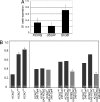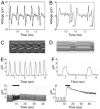KCNQ potassium channel mutations cause cardiac arrhythmias in Drosophila that mimic the effects of aging
- PMID: 17360457
- PMCID: PMC1820688
- DOI: 10.1073/pnas.0609278104
KCNQ potassium channel mutations cause cardiac arrhythmias in Drosophila that mimic the effects of aging
Abstract
Population profiles of industrialized countries show dramatic increases in cardiovascular disease with age, but the molecular and genetic basis of disease progression has been difficult to study because of the lack of suitable model systems. Our studies of Drosophila show a markedly elevated incidence of cardiac dysfunction and arrhythmias in aging fruit fly hearts and a concomitant decrease in the expression of the Drosophila homolog of human KCNQ1-encoded K(+) channel alpha subunits. In humans, this channel is involved in myocardial repolarization, and alterations in the function of this channel are associated with an increased risk for Torsades des Pointes arrhythmias and sudden death. Hearts from young KCNQ1 mutant fruit flies exhibit prolonged contractions and fibrillations reminiscent of Torsades des Pointes arrhythmias, and they exhibit severely increased susceptibility to pacing-induced cardiac dysfunction at young ages, characteristics that are observed only at advanced ages in WT flies. The fibrillations observed in mutant flies correlate with delayed relaxation of the myocardium, as revealed by increases in the duration of phasic contractions, extracellular field potentials, and in the baseline diastolic tension. These results suggest that K(+) currents, mediated by a KCNQ channel, contribute to the repolarization reserve of fly hearts, ensuring normal excitation-contraction coupling and rhythmical contraction. That arrhythmias in both WT and KCNQ1 mutants become worse as flies age suggests that additional factors are also involved.
Conflict of interest statement
The authors declare no conflict of interest.
Figures




Similar articles
-
Dysfunction of delayed rectifier potassium channels in an inherited cardiac arrhythmia.Ann N Y Acad Sci. 1999 Apr 30;868:406-13. doi: 10.1111/j.1749-6632.1999.tb11302.x. Ann N Y Acad Sci. 1999. PMID: 10414310 Review.
-
C-terminal HERG mutations: the role of hypokalemia and a KCNQ1-associated mutation in cardiac event occurrence.Circulation. 1999 Mar 23;99(11):1464-70. doi: 10.1161/01.cir.99.11.1464. Circulation. 1999. PMID: 10086971
-
Evidence for a cardiac ion channel mutation underlying drug-induced QT prolongation and life-threatening arrhythmias.J Cardiovasc Electrophysiol. 2000 Jun;11(6):691-6. doi: 10.1111/j.1540-8167.2000.tb00033.x. J Cardiovasc Electrophysiol. 2000. PMID: 10868744
-
KCNE2 confers background current characteristics to the cardiac KCNQ1 potassium channel.EMBO J. 2000 Dec 1;19(23):6326-30. doi: 10.1093/emboj/19.23.6326. EMBO J. 2000. PMID: 11101505 Free PMC article.
-
The molecular genetics of the long QT syndrome: genes causing fainting and sudden death.Annu Rev Med. 1998;49:263-74. doi: 10.1146/annurev.med.49.1.263. Annu Rev Med. 1998. PMID: 9509262 Review.
Cited by
-
Mechanical Regulation of Cardiac Aging in Model Systems.Circ Res. 2016 May 13;118(10):1553-62. doi: 10.1161/CIRCRESAHA.116.307472. Circ Res. 2016. PMID: 27174949 Free PMC article. Review.
-
Fermitins, the orthologs of mammalian Kindlins, regulate the development of a functional cardiac syncytium in Drosophila melanogaster.PLoS One. 2013 May 15;8(5):e62958. doi: 10.1371/journal.pone.0062958. Print 2013. PLoS One. 2013. PMID: 23690969 Free PMC article.
-
Non-invasive red-light optogenetic control of Drosophila cardiac function.Commun Biol. 2020 Jun 29;3(1):336. doi: 10.1038/s42003-020-1065-3. Commun Biol. 2020. PMID: 32601302 Free PMC article.
-
SERCA is critical to control the Bowditch effect in the heart.Sci Rep. 2018 Aug 20;8(1):12447. doi: 10.1038/s41598-018-30638-9. Sci Rep. 2018. PMID: 30127403 Free PMC article.
-
Straightjacket/α2δ3 deregulation is associated with cardiac conduction defects in myotonic dystrophy type 1.Elife. 2019 Dec 12;8:e51114. doi: 10.7554/eLife.51114. Elife. 2019. PMID: 31829940 Free PMC article.
References
-
- Thom TNH, Rosamond W, Howard VJ, Rumsfeld J, Manolio T, Zheng Z, Flegal K, O'Donnell C, Kittner S, Lloyd-Jones D, et al. Circulation. 2006;113:e85–e151. - PubMed
-
- Lakatta EG. Heart Fail Rev. 2002;7:29–49. - PubMed
-
- Lakatta EG, Levy D. Circulation. 2003;107:346–354. - PubMed
-
- Priori SG, Napolitano C. Ann NY Acad Sci. 2004;1015:96–110. - PubMed
-
- Bodmer R. Trends Cardiovasc Med. 1995;5:21–27. - PubMed
Publication types
MeSH terms
Substances
LinkOut - more resources
Full Text Sources
Other Literature Sources
Medical
Molecular Biology Databases

